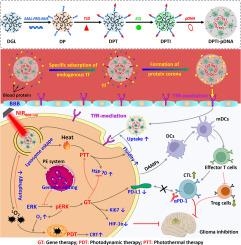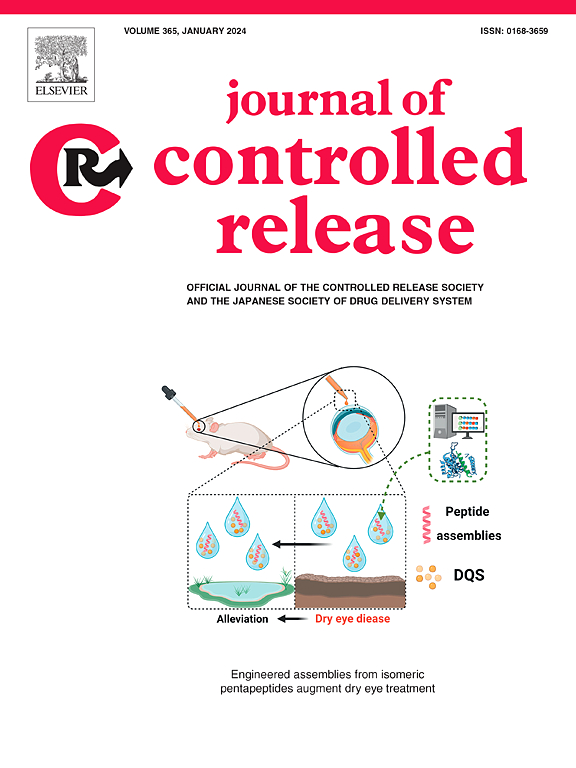克服多重障碍,为胶质瘤靶向联合疗法提供光基因系统。
IF 10.5
1区 医学
Q1 CHEMISTRY, MULTIDISCIPLINARY
引用次数: 0
摘要
克服传递大分子药物的多重障碍是胶质瘤治疗面临的一项紧迫挑战。本文提出了一种基于T10肽修饰和吲哚菁绿(ICG)负载树枝状聚L-赖氨酸的蛋白冠调节协同光激活策略,以增强胶质瘤的素编辑治疗。首先,修饰后的T10肽可通过与内源性转铁蛋白的特异性结合,摆脱血液中蛋白质冠的干扰屏障,从而穿越血脑屏障(BBB),实现对胶质瘤细胞的靶向识别。其次,负载的ICG可以削弱肿瘤基质屏障,降低细胞膜屏障,并通过其光热效应和光动力效应逃避溶酶体降解/自噬屏障。随后,可下调 p-ERK1/2 以抑制肿瘤生长和免疫调节的治疗基因可被有效地传递到胶质瘤细胞中。胶质瘤靶向光基因联合免疫疗法有效抑制了胶质瘤的生长,尤其是与 PD-1 抗体联合使用时。本文章由计算机程序翻译,如有差异,请以英文原文为准。

Overcoming multiple barriers to deliver photo-gene system for glioma-targeted combined therapy
Overcoming multiple barriers to deliver macromolecular drugs is an urgent challenge for glioma treatment. Herein, a strategy of protein corona-regulation synergizing with photoactivation based on T10 peptide-modified and indocyanine green (ICG)-loaded dendrigraft poly-L-lysines was proposed to augment prime editing therapy of glioma. First, the modified T10 peptide could escape the interference barrier of protein crown in blood via its specific binding with endogenous transferrin, thus crossing the blood-brain barrier (BBB) and achieving the targeting recognition of glioma cells. Next, the loaded ICG could weaken the tumor stromal barrier, decrease the cell membrane barrier and escape the lysosomal degradation/autophagy barrier via its photothermal and photodynamic effects. Subsequently, a therapeutic gene that could downregulate p-ERK1/2 for tumor growth inhibition and immunoregulation could be effectively delivered into the glioma cells. The glioma-targeted photo-gene combined immunotherapy effectively inhibit the glioma growth, especially co-dosing with the PD-1 antibody.
求助全文
通过发布文献求助,成功后即可免费获取论文全文。
去求助
来源期刊

Journal of Controlled Release
医学-化学综合
CiteScore
18.50
自引率
5.60%
发文量
700
审稿时长
39 days
期刊介绍:
The Journal of Controlled Release (JCR) proudly serves as the Official Journal of the Controlled Release Society and the Japan Society of Drug Delivery System.
Dedicated to the broad field of delivery science and technology, JCR publishes high-quality research articles covering drug delivery systems and all facets of formulations. This includes the physicochemical and biological properties of drugs, design and characterization of dosage forms, release mechanisms, in vivo testing, and formulation research and development across pharmaceutical, diagnostic, agricultural, environmental, cosmetic, and food industries.
Priority is given to manuscripts that contribute to the fundamental understanding of principles or demonstrate the advantages of novel technologies in terms of safety and efficacy over current clinical standards. JCR strives to be a leading platform for advancements in delivery science and technology.
 求助内容:
求助内容: 应助结果提醒方式:
应助结果提醒方式:


